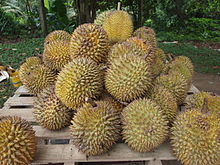Durian - Simple English Wikipedia, the free encyclopedia
| Durio | |
|---|---|
 | |
 | |
| Scientific classification | |
| Kingdom: | Plantae |
| Clade: | Tracheophytes |
| Clade: | Angiosperms |
| Clade: | Eudicots |
| Clade: | Rosids |
| Order: | Malvales |
| Family: | Malvaceae |
| Subfamily: | Helicteroideae |
| Tribe: | Durioneae |
| Genus: | Durio L. |
| Type species | |
| Durio zibethinus L. | |
| Species | |
| There are currently 30 recognised species (see the List of Durio species) | |
| Synonyms | |
| Lahia Hassk.[1] | |
A durian is a big fruit with a strong smell and a hard shell with sharp thorns. Its flavour is loved by some people, especially in Southeast Asia, where people name it "King of Fruits". Many hotels and public transportation systems do not let people carry durians because of the strong smell, which many people find unpleasant.
There are many different kinds of durian that are priced differently due to the people's preferences.
Appearance
[change | change source]The fruit can grow up to 30 cm (12 in) long and 15 cm (6 in) in diameter, and usually weighs one to three kg (2 to 7 lb).
Durian is a tropical fruit. It grows only in humid, hot places. The flesh is used for many dishes in Southeast Asian cuisines. The seeds can also be eaten when cooked.
References
[change | change source]- ↑ "Durio L." Germplasm Resources Information Network. United States Department of Agriculture. 2007-03-12. Retrieved 2010-02-16.


 French
French Deutsch
Deutsch